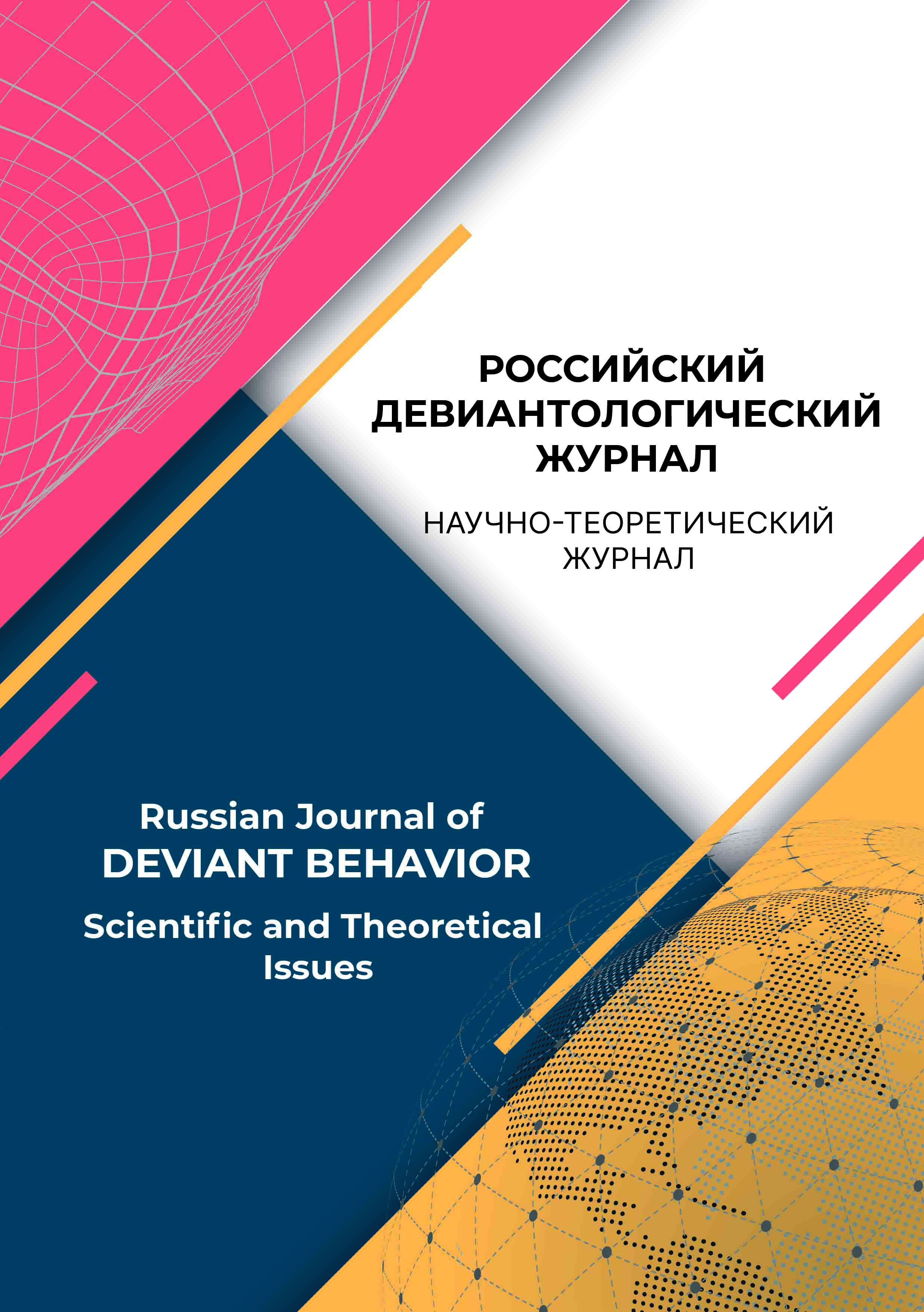employee
Saint-Petersburg, St. Petersburg, Russian Federation
from 01.01.2006 to 01.01.1923
Kostanay, Kazakhstan
UDC 159.99
Introduction. While studying recidivism prediction, criminal risk assessment is considered in many countries a mandatory procedure. The paper presents the most widely known and frequently applied risk assessment tools. Special attention is paid to predicted risk assessment tools for individuals released in the Russian Federation and the Republic of Kazakhstan. Taking into account the emerging tradition of using these risk assessment tools for practical purposes and the opportunities for conducting relevant research, much attention is paid to reviewing the tools used abroad. The purpose of the study is to provide the theoretical grounds for recidivism risk assessment tools, as well as the analysis of foreign experience in application and verification of this tool. Research methods. The research uses general scientific methods: (analysis, synthesis, systematization, generalization, analogy), special methods: comparative (when studying tools for assessing the risk of recidivism), formal legal (for the study of normative legal acts). Results. The research demonstrates a wide range of approaches and patterns in the area of criminal behavior risk assessment. Criminal behavior risk assessment tools were classified, and they can be summarised in a historical perspective into four generations according to chronology. The first and least reliable approach is to assess the risk of recidivism based on the clinical opinion of professionals. At this stage the measurement was characterised by its subjectivity. The second generation was based on actuarial valuation using reliable statistical predictors and significance levels for recidivism. The third generation tended to combine risk factors based on the theory of static risk assessment. The fourth generation of tools is based on the understanding that risk should be assessed as a continuous and dynamic process related to both the risk itself and the needs and resources of the individual. This approach considers that offenders’ supervision in post-penitentiary probation is an effective means of successful risk assessment based on their individual psychological characteristics and resources.
criminal riskology, prediction, criminogenicity, risk assessment, recidivism, administrative supervision
1. Babaev, M. M., Pudovochkin, Yu. E. (2019). Fenomen riska v kontekste profilakticheskoj politiki (kriminal'naya riskologiya). Vestnik Sankt-Peterburgskogo universiteta. Pravo, 10 (1), 136–148. https://doi.org/10.21638/spbu14.2019.110
2. Golenko, D. V. (2018). Problemy i ozhidaemye rezul'taty kriminologicheskogo prognozirovaniya povedeniya lic, otbyvshih nakazanie. Yuridicheskij vestnik Samarskogo universiteta, 4 (2), 111–117. https://doi.org/10.18287/2542-047X-2018-4-2-111-117
3. Debol'skij, M. G. (2014). Problemy riska recidiva pri uslovno-dosrochnom osvobozhdenii osuzhdennyh [Elektronnyj resurs]. Psihologiya i pravo. 4 (1). URL: https://psyjournals.ru/journals/psylaw/archive/2014_n1/68316 (data obrashcheniya: 12.03.2024)
4. Druzhininskaya, O. V., Titova, O. Z. (2023). Reprezentaciya yuridicheskogo ponyatiya PROBATION v anglijskoj yuridicheskoj terminologii. Filologicheskie nauki. Voprosy teorii i praktiki, 16 (12), 4277–4282. https://doi.org/10.30853/phil20230650
5. Dushkin, A. S. (2022). Prognozirovanie prestuplenij lic, sostoyashchih pod administrativnym nadzorom: ponyatie i osnovnye metody. V Rossijskaya deviantologicheskaya panorama: teoriya i praktika: materialy mezhdunarodnoj nauchno-prakticheskoj konferencii (Sankt-Peterburg, 30 sentyabrya 2022 goda, str. 88–92). Saint Petersburg: Sankt-Peterburgskij universitet MVD Rossii.
6. Dyadchenko, E. A. (2013). Problema psihologicheskogo prognoza recidivnyh prestuplenij nesovershennoletnih, otbyvayushchih nakazaniya, ne svyazannye s lisheniem svobody. Vestnik Samarskogo yuridicheskogo instituta, 2 (10), 65–69.
7. Dyadchenko, E. A. (2017). Psihologicheskij prognoz recidiva (zarubezhnyj opyt ocenki risk-faktorov u nesovershennoletnih osuzhdennyh). V Yuridicheskaya nauka i praktika: al'manah nauchnyh trudov Samarskogo yuridicheskogo instituta FSIN Rossii (Samara, 1-2 iyunya 2017 goda, Tom Vypusk 5, chast' 1, str. 89–93). Samara: Samarskij yuridicheskij institut Federal'noj sluzhby ispolneniya nakazanij.
8. Mel'nikova, D. V. (2022). Uchastie psihologa v prinyatii resheniya o rekomendacii osuzhdennogo k uslovno-dosrochnomu osvobozhdeniyu. Psihologiya i pravo, 12 (1), 30–43. https://doi.org/10.17759/psylaw.2022120103
9. Novikov, E. E. (2016). Ob osnovah prognozirovaniya individual'nogo povedeniya osuzhdennyh k al'ternativnym nakazaniyam i meram. Aktual'nye problemy rossijskogo prava, 8 (69), 153–159. https://doi. org/10.17803/1994-1471.2016.69.8.153-159
10. Potapov, A. M., Kulikov, S. G. (2022). Ob osobennostyah postpenitenciarnogo kontrolya za licami, otbyvshimi nakazanie v vide lisheniya svobody, v ugolovno-ispolnitel'nom zakonodatel'stve otdel'nyh stran–uchastnikov Sodruzhestva Nezavisimyh Gosudarstv. Vedomosti ugolovno-ispolnitel'noj sistemy, 12 (247), 21–29. https://doi.org/10.51522/2307-0382-2022-247-12-21-29
11. Alikhademi, K., Drobina, E., Prioleau, D., Richardson, B., Purves, D., & Gilbert, J. E. (2021). A review of predictive policing from the perspective of fairness. Artificial Intelligence and Law, 30 (1), 1–17.
12. Andrews, D. A., Bonta, J., & Wormith, J. S. (2011). The Risk-Need-Responsivity (RNR) Model: Does adding the Good Lives Model contribute to effective crime prevention? Criminal Justice and Behavior, 38 (7), 735–755. https://doi.org/10.1177/0093854811406356
13. Bullock, K. (2011). The Construction and Interpretation of Risk Management Technologies in Contemporary Probation Practice. The British Journal of Criminology, 51 (1), 120–135.
14. Douglas, K. S., Hart, S. D., Webster, C. D., Belfrage, H., Guy, L. S., & Wilson, C. M. (2014). Historical- Clinical-Risk Management-20, Version 3 (HCR-20V3): Development and Overview. International Journal of Forensic Mental Health, 13 (2), 93–108. https://doi.org/10.1080/14999013.2014.906519
15. Fitzgibbon, W., & Green, R. (2006). Mentally Disordered Offenders: Challenges in using the OASys risk assessment tool. British Journal of Community Justice, 4.
16. Grove, W. M., & Meehl, P. E. (1996). Comparative efficiency of informal (subjective, impressionistic) and formal (mechanical, algorithmic) prediction procedures: The clinical–statistical controversy. Psychology, Public Policy, and Law, 2 (2), 293–323. https://doi.org/10.1037/1076-8971.2.2.293
17. Hanson, R. (2009). The psychological assessment of risk for crime and violence. Canadian Psychology / Psychologie canadienne, 50 (3), 172–182. https://doi.org/10.1037/a0015726
18. Lancaster, E., & Lumb, J. (2006). The assessment of risk in the national probation service of England and Wales. Journal of Social Work, 6 (3), 275–291. https://doi.org/10.1177/1468017306071176
19. Looman, J., & Abracen, J. (2013). The risk need responsivity model of offender rehabilitation: Is there really a need for a paradigm shift? International Journal of Behavioral Consultation and Therapy, 8 (3-4), 30–36. https://doi.org/10.1037/h0100980
20. McKay, C. (2020). Predicting risk in criminal procedure: actuarial tools, algorithms, AI and judicial decision-making. Current Issues in Criminal Justice, 32 (1), 22–39. https://doi.org/10.1080/10345329. 2019.1658694
21. Farayola, M. M., Tal, I., Connolly, R., Saber, T., & Bendechache, M. (2023). Ethics and Trustworthiness of AI for Predicting the Risk of Recidivism: A Systematic Literature Review. Information, 14 (8), 426. https://doi.org/10.3390/info14080426
22. Ward, T., Mann, R. E., & Gannon, T. A. (2007). The good lives model of offender rehabilitation: Clinical implications. Aggression and Violent Behavior, 12 (1), 87–107. https://doi.org/10.1016/j.avb.2006.03.004














